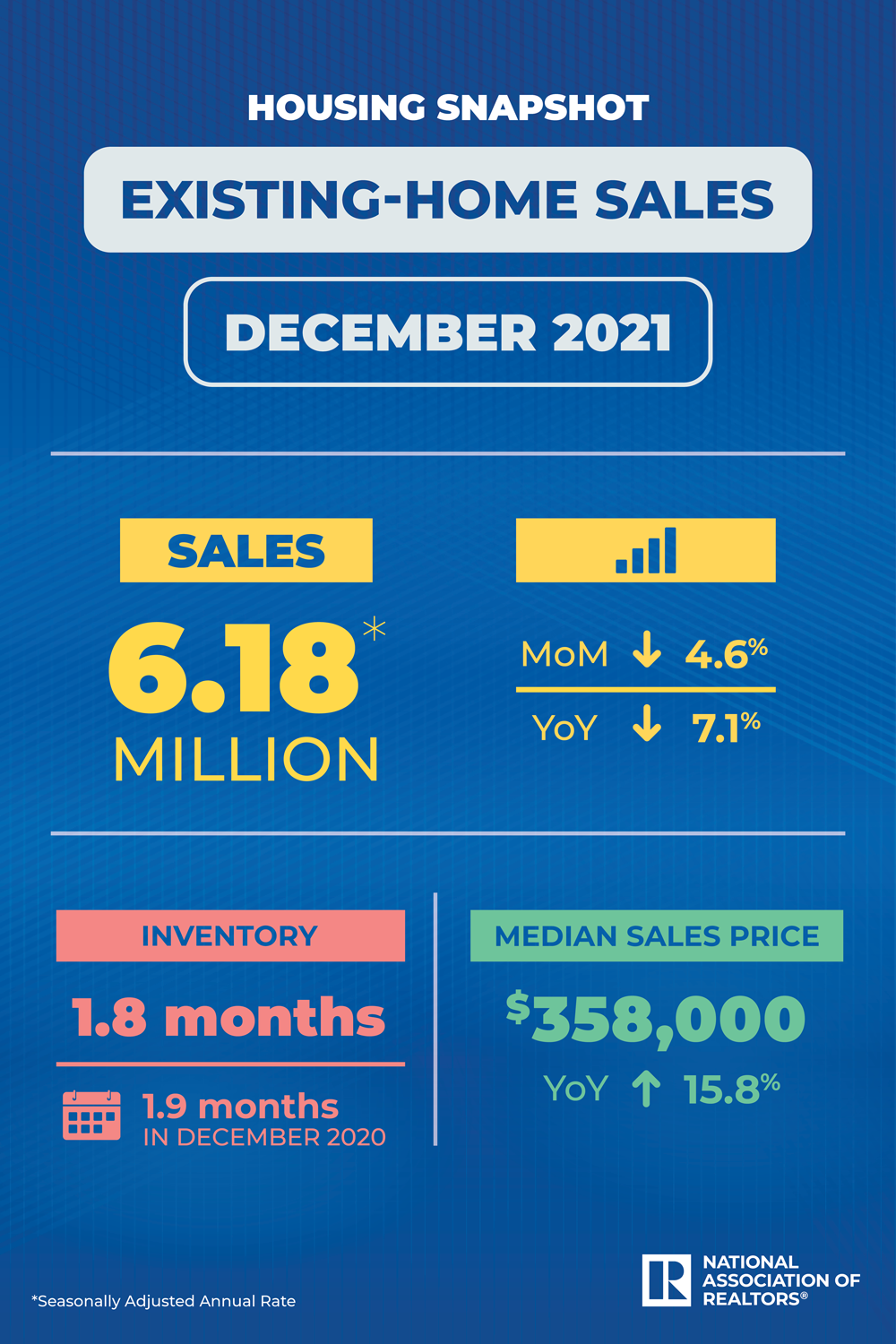Existing-home sales ended 2021 on a high note as home buyers rushed to buy a home to take advantage of ultra-low mortgage rates. Overall, sales were up 8.5% in 2021 compared to 2020, the National Association of REALTORS® reported Thursday. But the new year could bring about lower sales numbers as more buyers become priced out and find fewer and fewer choices of homes for sale.
The signs of a slight slowdown are already popping up. In December 2021, while unsold existing homes fell to an all-time low, home sales also dropped. Total existing-home sales—completed transactions that include single-family homes, townhomes, condos, and co-ops—fell 4.6% in December compared to November, NAR reports. Each of the four major regions of the U.S. posted month-over-month and year-over-year declines.
“December saw sales retreat, but the pullback was more a sign of supply constraints than an indication of a weakened demand for housing,” says Lawrence Yun, NAR’s chief economist. “Sales for the entire year finished strong, reaching the highest annual level since 2006.”
What Lies Ahead
Yun expects existing-home sales to slow slightly in the coming months as mortgage rates rise. However, he notes that recent employment gains and stricter underwriting standards will protect home sales and that housing is “in no danger of crashing.” Yun forecasts mortgage rates to remain below 4% by the end of 2022 and wages to hold firm.
“This year consumers should prepare to endure some increases in mortgage rates,” Yun says. “I also expect home prices to grow more moderately by 3% to 5% in 2022, and then similarly in 2023 as more supply reaches the market.”
Snapshot of 5 Key Housing Indicators
Here’s a closer look at the leading housing metrics from NAR’s latest housing report:
- Home prices: The median existing-home price for all housing types in December was $358,000, up 15.8% compared to December 2020 ($309,200). Every major region of the U.S. posted gains, led by the South.
- Inventory: Total housing inventory at the end of December was 910,000 units, down 18% compared to November 2021 and a decrease of 14.2% from a year ago. “We saw inventory numbers hit an all-time low in December,” Yun says. “Home builders have already made strides in 2022 to increase supply, but reversing gaps like the ones we’ve seen recently will take years to correct.”
- Days on the market: Seventy-nine percent of homes sold in December 2021 were on the market for less than a month. Properties typically remained on the market for 19 days in December, down from 21 days in December 2020.
- First-time home buyers: First-time house hunters comprised 30% of sales in December 2021, up from 26% in November. “There was a significant surge in first-time buyers at the end of the year,” Yun says. “With mortgage rates expected to rise in 2022, it’s likely that a portion of December buyers were intent on avoiding the inevitable rate increases.”
- Investors and second-home buyers: Individual investors or second-home buyers, who make up many cash sales, purchased 17% of homes in December, up from 14% in December 2020. All-cash sales comprised 23% of transactions in December, up from 19% from December 2020.
Regional Breakdown
Here are how existing-home sales fared in December 2021 across the country:
- Northeast: Existing-home sales dropped 1.3%, registering an annual rate of 750,000, a 15.7% decrease from December 2020. Median price: $384,600, up 6.3% from one year ago.
- Midwest: Existing-home sales fell 1.3% to an annual rate of 1.5 million in December, a 2.6% decline from a year ago. Median price: $256,900, a 10.0% climb from December 2020.
- South: Existing-home sales dropped 6.3% in December, posting an annual rate of 2.7 million, a drop of 5.3% from one year ago. Median price: $323,000, a 20.2% decrease from a year ago.
- West: Existing-home sales dropped 6.8%, reporting an annual rate of 1.23 million in December, down 10.2% from one year ago. Median price: $507,100, up 8.4% from December 2020.













